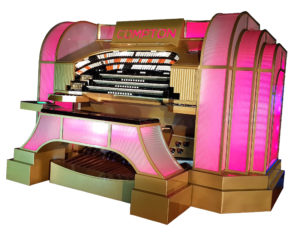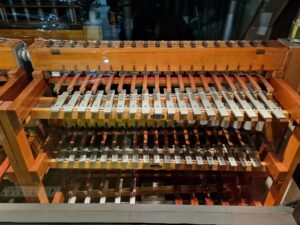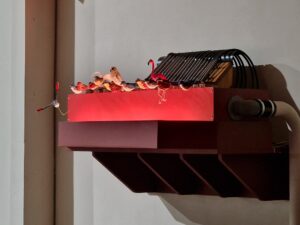Pipes in the Peaks has 2 resident organists, and we also regularly feature the very best guest organists for your entertainment.
Occasionally, we also feature other guest artists and bands to add to your experience!
Over the years we have invited many guest organists to play the Mighty Pipes in the Peaks Compton in concert. We have featured Phil Kelsall MBE, Robert Wolfe, Nigel Ogden, Nicholas Martin BEM, Chris Powell, Kevin Grunill, John Mann, Jean Martyn and Donald MacKenzie.
| Christian is one of the younger generation of organists who is not only interested in playing, but also in the intricate restoration side of these fine historic instruments. Along with his brother, Christopher, a Christie organ is being completely renovated. |
| He was taken to the Ballroom at Blackpool Tower from early infancy, and from around the age of 3 he started ‘playing’ a keyboard. He then progressed to an electronic organ and eventually used a vintage Compton 357 Melotone. He first sat at the console of a theatre organ in January 1999 (the WurliTzer 3/8 of Burton Town Hall in fact) and has since played a varied selection of British and American theatre organs, most notably the 74+ rank WurliTzer at the OrganStop Pizza Parlour in Phoenix Arizona, and also the 80 rank WurliTzer of the amazing Sanfillippo residence in Chicago, Illinois. During 2001, Christian was made assistant organist at the Pipes In The Peaks Compton. He can be seen many times in concert at this particular venue. |

|

At the OrganStop 4/74 WurliTzer |
| Christian is completely self taught, and has spent many, many hours listening, watching and studying recordings of the masters of the instrument past and present. He likes to present a wide selection of music for all tastes and ages, and his many styles of interpretation are his own arrangments. He found influences from the likes of American artistes such as Lyn Larsen and Ron Rhode, to the British counterparts in particular the late Vic Hammett, and of course the ever popular Phil Kelsall. |
 With Mum, Dad and brother Christopher at my Graduation Ceremony. With Mum, Dad and brother Christopher at my Graduation Ceremony. |
Christian is a Batchelor of Science, having graduated from Staffordshire University, and is employed in a non-music related position. His other interests are Steam and Traction Engines, Classic Cars, and F1 Motor Racing. He also likes listening to many types of music, especially Katie Melua, Shania Twain, and the Mavericks. |
Since the opening in 1999, Stephen Foulkes has been organist here at ‘Pipes In The Peaks’. He has also held the same position from 1993 at the ex-Granada Greenford WurliTzer housed at the M-Ranch at Sutton-in-Ashfield near Mansfield.
 |
Stephen was born at an early age in 1972, the proud Son of parents, Mrs Glenda and Mr Adrian Foulkes. His younger brother Paul, joined the family a few years later.Like many other younger organists of today, he started playing the organ at the tender age of 7. This was after first going to hear, and being inspired by a youthful Phil Kelsall, at the WurliTzer of Blackpool Tower Ballroom. |
While studying music with the Associated Board of Royal Schools of Music, he passed Grade 8 by 15. His studies were furthered with the London College of Music Diploma.
At work, Stephen is office manager for a Chartered Accountancy. He is a Fellow of the Association of Accounting Technicians, a Member of the Association of Chartered Certified Accountants.
Apart from organ music, Stephen’s relaxes to his music collection which contains a wide variety of styles including Big Band, Glenn Miller, Ted Heath, and a whole range of Classical music. He also has a great appreciation of the composer John Williams, and the Mavericks.
His first contact with the Cinema Organ around 1988, in the form of training on the WurliTzer, which was until 2001 located in the Silver Jubilee Club, West Hallam, Derbyshire. Stephen followed in the footsteps at this venue of other famous names, including Nicholas Martin and Robert Wolfe. At this time he was introduced to David Thorp, prior to his purchase of the Regal/ABC Derby Compton.
Both Stephen, and his brother Paul have been popular throughout the UK, with Stephen performing on the organ and Paul accompanying on a variety of Brass instruments, keyboards and vocals.
In 1993, Stephen booked the Tower Ballroom for his own concert, after finishing a series of events at venues such as Burton Town-Hall. He still makes regular appearances for concerts and dancing around the country, both on pipes and electronics.
Since their first meeting, David and Stephen have become great friends. After David obtained his Comtpon, they have worked closely on it’s re-specification, and the visual aspects of the venue.
Recently, both Stephen and Paul have written and arranged music for an Alpine Horn band in Switzerland. Paul is currently in charge of the music department, at one of the countries’ premier and exclusive boarding schools.
Recordings
Stephen has made 2 recordings of himself, featuring some tracks with Paul on Brass instruments, recorded on the M-Ranch WurliTzer (as seen on Phil Kelsall video “Going for Gold”). Tracks are often featured on BBC Radio 2, “The Organist Entertains”.
Copies of the recordings are available at his concerts.
This is your chance to see the ex-Regal/ABC Compton. This page make take longer to download due to the number of pictures contained on it Click on a picture to get a closer view!
All of the pictures contained are as the organ is installed at ‘Pipes In The Peaks’.
Console:
The Compton Console.
|
 |
 |
Close up of console, showing the recent addition of the drawer to augment the number of stops available to the organist.
|
|
|
Pipe Chamber:
 |
Left-hand side of Pipe Chamber.
Ranks in this side are from Left to Right:-
Tibia 1, Brass Trumpet, Clarinet, Vox Humana, English Horn, Viol, Open Diapason, Viol Celeste, and Concert Flute.
On the rear wall can be seen the 8′ Viol pipes. 8′ Cello pipes, and the larger 16′ English Horn, 16′ Tibia and 8′ Diapason
|
| Right-hand side of Pipe Chamber
Ranks in this side are from Left to Right:-
Cello Celeste, Quintadena, Cello, Tuba Horn, Muted Trumpet, Kinura, Krumet, Tibia 2, Brass Saxophone.
On the far left wall can be seen the wooden Bourdon and metal Diaphone, on the back wall is the 16′ Tuba, just in front the 8′ Tibia 2, and on the right can be seen the Xylophone and Glockenspiel units.
|
 |
Automated Drum Kit:
 |
The fully automated drum kit. Drum kit includes,
Bass Drum, Snare Drum, Rim shot, Tom 1, Tom 2, Tom 3, High Hat Open, High Hat Closed, High Hat Tap, Splash Cymbal, China Crash, Bell, Ride 1, Crash 1, Ride 2, Crash 2, Clave, Tambourine, Wood Block, Cow Bell, Temple Blocks.
All instruments have complete expression from silent to full volume. All the instruments are timed precisely to within one thousandth of a second!
|
Compton Solo Cello:
 |
The very rare Compton Solo Cello. A single string is located on the left hand side of the unit, with 37 fingers that produce each of the notes. The unit can only play a single note at a time, always the highest of a chord. At the bottom of the string is the mechanical circular bow, which just like the real bow in a orchestra also requires rosin to be applied. Beside the bow is an electromagnetic pickup device, not dissimilar to the principle used in an electric guitar, which is fed into an amplifier and speaker. At the bottom of the unit is an electric motor which drives the bowing and vibrato on the unit. Seen on the right hand side, is the control linkage and spring arrangement used to control the string tension which applies the vibrato.
|
Piano Accordion:
 |
A real Piano Accordion, which is played directly from the organ
|
Toy Counter:
|
 |
Main Toy Counter Unit includes,
Bass Drum F and P, Bass Drum Roll, Snare Drum, Syren, Bird Whistle, Wood Block, Sleigh Bells, Castanets, Tambourine, Steamboat Whistle, Engine Whistle, Cymbal Tap, Cymbal Roll, Tom Tom, Triangle, Sand Block.
|
Vibraphone:
 |
A Compton Vibraphone. Control 37 notes. Can either be used as a Vibraphone by the means of butterflies spinning in the resonators, or as a Chrysoglott.
|
Xylophone and Glockenspiel:
|


|
Top – Xylophone 37 notes
Bottom – Glockenspiel 37 notes
|
Piano:
 |
Upright Broadwood Piano attachment, which can be played directly from the organ, with keys that appear to move “as if by magic”
|
Cathedral Chimes:
 |
18 note Christie Cathedral Chimes. |
Marimba:
 |
Here is the 61note Deagan Marimba. It runs on 12inch Water Gauge of Wind Pressure, and took a whole day to lift it’s 4 sections into place, after weeks of painstaking renovation and releathering.
It is believed to be the largest compass instrument fitted to a Cinema Organ in the UK. This plays a full 61 notes. |
Secondary Toy Counter:
 |
Located on this unit as designed and manufactured by Pipes in the Peaks are:-
Jazz Cymbal F and P, Brush Cymbal, Splash Cymbal, Cop Whistle, and Sante Fe Whistle.
|
Tuned Birds, Duck and Owl:
 |
The Compton has a set of 18-note tuned bird whistles, based on those sometimes fitted to Christie organs in the 1930’s. The 18 pre-tuned pipes sit upside-down in a bath of water, and have some flying birds to add to the amusement. There are owl and duck effects too.
|
New Toy Counter
|

|
New toy counter features from left to right:
- The original Compton Klaxon
- 2nd Compton Crash Cymbal
- Wurlitzer Toy Counter featuring Telephone Bell, Firebell, Steamboat Whistle, Horses Hooves, Castanets, Wood Block Tap, Triangle
- Wurlitzer Aeroplance
- 2nd Klaxon
- Wurlitzer Wind Effect
- Wurlitzer Surf
- Wurlitzer Tambourine
- Wurlitzer Choke Cymbal
- Slide Whistle
- Duck
- Original Compton Crash Cymbal
- Original Compton Bird Whistle
|
Melotone


|
Series 3 Melotone. Unfortunately the original Series 3 Melotone was present when the Compton was purchased for Pipes in the Peaks, but luckily we managed to acquire an identical unit which completes the original specification of the Compton. The melotone is an electostatic device which produces synthetic organ sounds, vibraphone, marimba, and carillon.
Top picture shows the actual Melotone unit
Bottom picture shows the Horn Speaker which it plays through. |
Tuned Sleigh Bells
|

|
A very early set of Wurlitzer Tuned Sleigh Bells which date back to 1915. |
Tuned Sleigh Bells
 |
Temple Blocks, Cowbell and Wind Chimes |
Tuned Sleigh Bells
 |
14 note external Tibia Bass |
Chinese Gong
 |
Kimball Chinese Gong |
« Older Posts


























